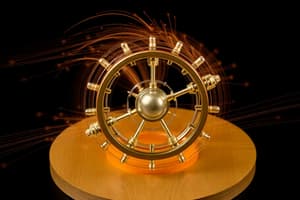Podcast
Questions and Answers
Which concept describes how light bends as it passes from one medium to another?
Which concept describes how light bends as it passes from one medium to another?
- Reflection
- Diffraction
- Refraction (correct)
- Interference
What describes the superposition of light waves that can enhance or diminish light intensity?
What describes the superposition of light waves that can enhance or diminish light intensity?
- Diffraction
- Interference (correct)
- Refraction
- Polarization
Which principle of modern physics describes gravitation as a curvature of spacetime?
Which principle of modern physics describes gravitation as a curvature of spacetime?
- Quantum mechanics
- Special relativity
- General relativity (correct)
- Newtonian mechanics
Which of the following concepts refers to the direction of the oscillation of light waves?
Which of the following concepts refers to the direction of the oscillation of light waves?
Which aspect of modern physics seeks to explain phenomena at the atomic and subatomic levels?
Which aspect of modern physics seeks to explain phenomena at the atomic and subatomic levels?
What does Newton's first law state about an object in motion?
What does Newton's first law state about an object in motion?
Which law of thermodynamics states that the total entropy of an isolated system can only increase?
Which law of thermodynamics states that the total entropy of an isolated system can only increase?
What does Maxwell's equations govern in the context of electromagnetism?
What does Maxwell's equations govern in the context of electromagnetism?
What does the first law of thermodynamics describe?
What does the first law of thermodynamics describe?
Which of these concepts is NOT typically analyzed in classical mechanics?
Which of these concepts is NOT typically analyzed in classical mechanics?
What describes the behavior of light in optics?
What describes the behavior of light in optics?
What is a direct consequence of Newton's second law?
What is a direct consequence of Newton's second law?
Which law of thermodynamics describes the behavior of systems as temperature approaches absolute zero?
Which law of thermodynamics describes the behavior of systems as temperature approaches absolute zero?
Flashcards
Reflection
Reflection
The process of light bouncing off a surface. Think of a mirror reflecting your image.
Refraction
Refraction
The bending of light as it passes from one medium to another, like from air to water. This causes objects to appear distorted in water.
Diffraction
Diffraction
The spreading out of light waves as they pass through an opening or around an obstacle. This is why you can see light spilling out from behind a closed door.
Interference
Interference
Signup and view all the flashcards
Polarization
Polarization
Signup and view all the flashcards
Classical Mechanics
Classical Mechanics
Signup and view all the flashcards
Newton's First Law of Motion (Law of Inertia)
Newton's First Law of Motion (Law of Inertia)
Signup and view all the flashcards
Newton's Second Law of Motion
Newton's Second Law of Motion
Signup and view all the flashcards
Newton's Third Law of Motion
Newton's Third Law of Motion
Signup and view all the flashcards
Thermodynamics
Thermodynamics
Signup and view all the flashcards
First Law of Thermodynamics
First Law of Thermodynamics
Signup and view all the flashcards
Electromagnetism
Electromagnetism
Signup and view all the flashcards
Maxwell's Equations
Maxwell's Equations
Signup and view all the flashcards
Study Notes
Classical Mechanics
- Classical mechanics describes the motion of macroscopic objects, typically at low speeds and under the influence of familiar forces, like gravity and electromagnetism.
- It's based on Newton's laws of motion, which relate force, mass, and acceleration.
- Newton's first law (law of inertia): An object at rest stays at rest and an object in motion stays in motion with the same speed and in the same direction unless acted upon by an unbalanced force.
- Newton's second law: The acceleration of an object is directly proportional to the net force acting on it and inversely proportional to its mass. (F = ma)
- Newton's third law: For every action, there is an equal and opposite reaction.
- Classical mechanics provides tools to analyze systems involving particles and rigid bodies, considering concepts like momentum, energy, and angular momentum.
- Important concepts include work-energy theorem, conservation of energy, and momentum.
Thermodynamics
- Thermodynamics deals with heat, temperature, and energy transfer.
- It describes how systems change over time as a result of these transfers.
- Key laws include the zeroth, first, second, and third laws of thermodynamics.
- The zeroth law defines thermal equilibrium.
- The first law describes the conservation of energy in thermodynamic processes.
- The second law states that the total entropy of an isolated system can only increase over time or remain constant in ideal cases.
- The third law describes the behavior of systems as the temperature approaches absolute zero.
- Applications are wide-ranging, from engines and refrigerators to chemical reactions and phase transitions.
Electromagnetism
- Electromagnetism describes the interactions between electric charges and magnetic fields.
- It's governed by Maxwell's equations, a set of four equations that summarize the fundamental laws.
- These equations relate electric and magnetic fields to their sources (charges and currents).
- Important concepts include electric fields, magnetic fields, electric potential, magnetic potential, and electromagnetic waves.
- Applications of electromagnetism are numerous and ubiquitous, including in technologies like generators, motors, and communications systems.
Optics
- Optics deals with the behavior of light.
- It covers different types of light, including visible light, ultraviolet light, and infrared light.
- Key concepts in optics include reflection, refraction, diffraction, interference, and polarization.
- Reflection describes how light bounces off surfaces.
- Refraction describes how light bends as it passes from one medium to another.
- Diffraction describes how light spreads out as it passes through an opening or around an obstacle.
- Interference describes the superposition of light waves to enhance or diminish light intensity.
- Polarization describes the direction of the oscillation of light waves.
Modern Physics
- Modern physics encompasses relativity and quantum mechanics, challenging classical concepts.
- Special relativity: Describes space and time as interconnected and relative to the observer's motion.
- General relativity: Describes gravitation as a curvature of spacetime caused by mass and energy.
- Quantum mechanics: Describes the behavior of matter at the atomic and subatomic level.
- Modern physics provides a framework for understanding phenomena like black holes, the behavior of particles, and the origin of the universe.
Studying That Suits You
Use AI to generate personalized quizzes and flashcards to suit your learning preferences.




